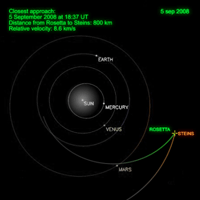Rosetta fine-tunes its approach to asteroid Steins
4 August 2008
On 4 August Rosetta starts to use its cameras to visually track asteroid Steins. These observations will be used to refine the trajectory of the spacecraft relative to Steins and to adjust it, if necessary, to achieve the desired fly-by conditions: 800 km distance at closest approach on 5 September at 18:37 UTC and zero phase angle reached prior to closest approach.
 |
|
Simulation of the Rosetta fly-by of asteroid Steins. (Click on the image to view a larger animation of the trajectory of Rosetta and the orbit of Steins.) |
The campaign begins when the spacecraft is at a distance of 24 million km from Steins and continues until 4 September at which time Rosetta will be at 950,000 km from the asteroid.
Currently the asteroid's orbit is known, from ground-based measurements, to an accuracy of about 100 km. With data from the navigation campaign it may be possible to reduce this to a few km (in the direction perpendicular to the flight direction of the asteroid). Data obtained after the navigation campaign, during the fly-by proper, will improve knowledge of the along track position to the same degree.
Images from OSIRIS and Navcam point the way
Both of Rosetta's navigation cameras (Navcams) and the OSIRIS narrow angle camera will be used during the optical navigation campaign. Several images of asteroid Steins will be acquired during allocated observing slots. For the first 3 weeks of the campaign 2 slots per week have been made available. During this period only OSIRIS can detect the asteroid since it is still too far away to be visible to the Navcams. From August 25 one slot per day is assigned to the optical navigation campaign. At this stage, and for the remainder of the navigation campaign, the two navigation cameras will also start to track the asteroid.
The acquired images are stored on-board the spacecraft and are transmitted to the ground-stations during the next available pass. The data is then transferred to the Rosetta Mission Operations Centre (RMOC) telemetry archive.
Navcam data are retrieved from the archive by the RMOC/Flight Dynamics System and are converted into raw images.
The OSIRIS data are retrieved by members of the OSIRIS team at the 'Max Planck Institut fuer Sonnensystemforschung' (MPS) and converted into raw images which are then made available to the Flight Dynamics System.
Both sets of raw data are processed in order to identify Steins and to determine accurately the inertial direction from the spacecraft to the asteroid based on the stellar background around the asteroid.
Determining the best flight path
Between now and closest approach on 5 September a number of opportunities arise for trajectory correction manoeuvres (see table) when the probe's thrusters can be fired to align the spacecraft trajectory relative to Steins. These manoeuvres will allow the spacecraft operators to fine-tune the approach of the spacecraft to the asteroid.
Preparations for the trajectory correction manoeuvres are performed according to the following processing cycle:
- Optical measurements: As described above several images are acquired by the NAVCAM and OSIRIS cameras. These are processed on ground to determine the direction of the spacecraft to asteroid.
- Orbit determination: The estimated orbits of the spacecraft and the asteroid are improved based on the optical measurements and radiometric data. (The latter is obtained routinely to determine the position of the spacecraft.)
- Manoeuvre optimisation: The size and direction of the required manoeuvres to correct the orbit are determined.
- Command generation: The final step is to generate the spacecraft commands to perform the required manoeuvres. These commands are sent to the spacecraft to be executed.
Challenging and demanding timeline
The turn-around time for a full processing cycle for a manoeuvre becomes shorter and more demanding the nearer to closest approach it is executed.
|
Timeline of Trajectory Correction Manoeuvres | ||
|
|
|
Comments |
| CA – 3 weeks | 14 August | Optical measurements taken before 11 August are available for the preparation of the manoeuvre |
| CA – 8 days | 28 August | Optical measurements taken up to and including 25 August will be taken into account |
| CA – 3 days | 2 September (15:30 UTC) |
The latest optical data available for this will be from 1 September 08:00 UTC |
| CA – 12 hours | 5 September (06:00 UTC) |
The latest optical data available for this will be from 4 September 17:00 UTC |
|
CA = closest approach (5 September 2008 at 18:37 UTC) | ||
Manoeuvres will be executed only if orbit corrections are necessary. Since the optical measurements become more accurate as the spacecraft approaches Steins it is quite likely that most, if not all, manoeuvres will be required.
The optical navigation campaign has been devised to ensure the best possible fly-by conditions for Rosetta as it approaches one of the key scientific targets of its 10 year mission.


